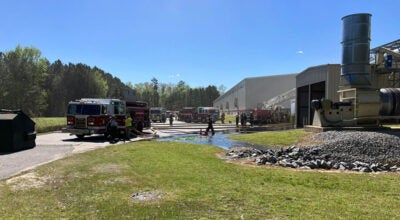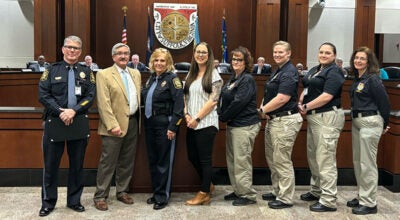Route 58 flyover project aims to make regional landfill access easier
Published 6:56 pm Friday, March 4, 2022
|
Getting your Trinity Audio player ready...
|
The Suffolk City Council this week received an update on the $39.4 million project to improve access to the regional landfill off of U.S. Routes 13, 58 and 460.
While it is expected to take another four years before it will be finished, parts of the project are moving forward, with geotechnical and survey fieldwork and preliminary design work having been completed last fall, and environmental fieldwork finished in January.
The project is needed as part of a conditional use permit council approved in 2017 with the Southeastern Public Service Authority requiring a new grade-separated entrance to the landfill before any waste can go into a new 73-acre cell, which has been in the planning stages since the early 1990s.
A flyover for traffic coming from the west on Route 58 to the landfill would meet the requirement and is being designed to handle traffic coming from Route 58 east. A bridge will be built as part of the flyover that will go over both sides of Route 58, allowing traffic to cross over the westbound lanes and get into the landfill.
It will be located about 3,000 feet east of the existing landfill entrance at the Bob Foeller Drive/Welsh Parkway intersection, the proposed location coming as a result of a 2016 traffic impact study from HDR engineering.
The proposed design of the flyover also has a right, eastbound exit ramp for traffic coming into the landfill from that direction. Traffic leaving the landfill will continue to use existing roads.
Without the flyover, the regional landfill would not be able to expand, and waste would have to be taken to private facilities, which SPSA says would result in sustained higher costs due to the lack of control over prices at private facilities, the need for more drivers, trucks and fuel, as well as an increase in carbon footprint and the lack of environmental oversight in waste handling.
The corridor has an estimated 80,000 vehicles drive past the regional landfill daily, and the intersection off of Route 58 and the landfill entrance has had numerous side-impact collisions, one of which resulted in the death of an SPSA employee in 2019.
“There’s becoming more and more traffic coming out of downtown Suffolk off Portsmouth Boulevard that comes through this crossover,” said Public Works Director Robert Lewis, “not to go into the SPSA landfill but actually to do a U-turn and go back west on the 58 Bypass. … This is becoming more and more of a critical location.”
The project will come in two phases, Lewis said, the first being to address the required improvements for SPSA to use the proposed new cell. The crossover area currently in place for westbound traffic to access the landfill will be eliminated with the project.
In Phase 2, “(city) staff will be reviewing and trying to find additional funding in the future (and) will also help with some of the weaving areas and making that even safer as we go forward.”
Lewis said the Virginia Department of Transportation, which is handling the work for the project, has posted a notice of a willingness to hold a public hearing.
Lewis said the reason to post that, rather than simply hold a public hearing, is because the project does not affect many landowners. Should there be significant enough interest, VDOT would then hold a public hearing.
VDOT has estimated preliminary engineering costs of around $6.7 million, right of way and utilities of nearly $3.7 million and construction more than $28.8 million. An increase in municipal tipping fees over the course of six years is being used to pay for the project. He said VDOT has indicated it can keep the project under budget despite current supply chain issues while operating in the midst of a pandemic.
“They’re hoping in three years when we go to construction everything is back to normal,” Lewis said. “They can actually beat that budget and save some funds on that.”
Lewis stressed that despite the project taking place in the city, “this is not a city of Suffolk project.” It’s a VDOT project, he said, with the state handling the design and construction of the project because it’s a regional project, since SPSA members span south Hampton Roads and the Western Tidewater areas of Franklin, Southampton County and Isle of Wight County.
Environmental fieldwork for the project finished up in late January, and the geotechnical and survey fieldwork finished up in September. The process to determine where the wetlands are that impact the project and the assessments for endangered and threatened species wrapped up in January. The preliminary design for the project also wrapped up last year.
VDOT will next take updated information about the project to what’s known as the Inter Agency Committee Meeting to review it with seven state agencies and five federal agencies. That’s expected in March.
Then, VDOT expects to have a detailed alternative analysis of the project completed by March or April, with project permits from the state Department of Environmental Quality, the U.S. Army Corps of Engineers and the DEQ Coastal Zone Management Consistency permits coming in July or August.
A field inspection is slated for August, with right-of-way acquisition for the project is scheduled for September 2022 through March 2023, with utility relocations taking place for the following year. VDOT plans to advertise the project in November 2023 and award the bid, then build it over a two-year period from April 2024 to late-April 2026.
Councilmembers who spoke about the project during a March 2 work session expressed support for it.
“There’s a lot of things going on with SPSA that deals with what type of trash and how we deal with it,” Lewis said. “It has to do with recycling, it has to do with waste and energy. All of those things play in, but the executive director of SPSA has stayed right on top of that to make sure that we’re balancing all of this so that the two projects coincide and we do not have a disruption in the ability to dispose of our refuge from the Hampton Roads region.”





